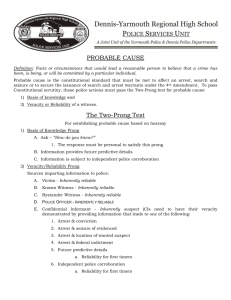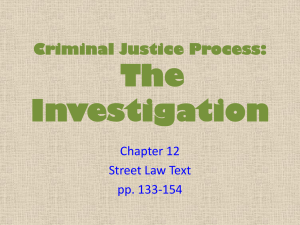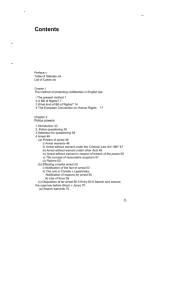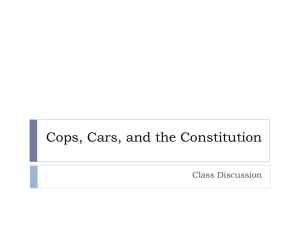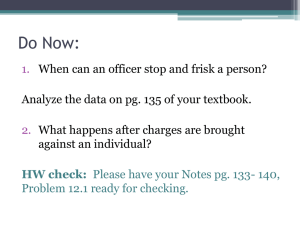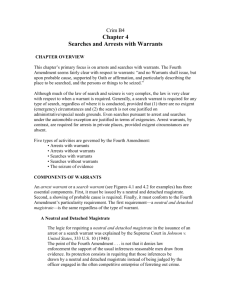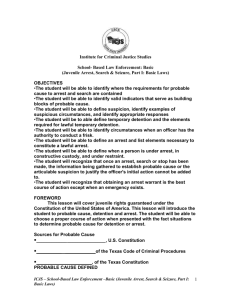Probable Cause and Arrest
advertisement
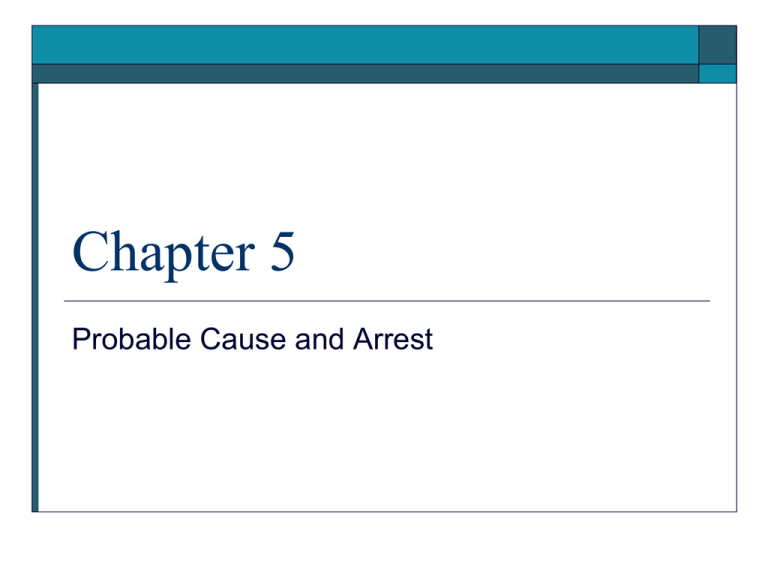
Chapter 5 Probable Cause and Arrest Arrest an individual is lawfully taken into custody more intrusive than an investigative stop and frisk formal arrest de facto arrest based on the totality of the circumstances a reasonable person would conclude that he/she is under arrest Probable Cause requires that a police officer objectively conclude, based on reasonably reliable facts, that a crime has been committed and that the person being arrested has committed the crime based on “common sense” “practical evaluation of the totality of the facts” cannot be reduced to a set of rules or to a mathematical formula Probable Cause (cont.) a matter of “probabilities” rather than “certainties” more than reasonable suspicion less than the beyond-a-reasonable-doubt standard direct observations hearsay The Aguilar-Spinelli Test two-pronged test veracity basis-of-knowledge both prongs must be satisfied in the affidavit established in Aguilar v. Texas supported by Spinelli v. United States Legal Equation Totality of the Circumstances Justice Black: “[n]othing in our Constitution . . . requires that the facts be established with that degree of certainty and with such elaborate specificity before a policeman can be authorized by a disinterested magistrate” to conduct an arrest or search based on probable cause Illinois v. Gates the veracity and basis-of-knowledge prongs are not independent requirements both of which must be established Totality (cont.) three aspects of a tip to be considered future action type of information corroboration Aguilar-Spinelli test very difficult to satisfy, especially with confidential informants concern in the dissent over the courts becoming “rubber stamps” for the police PC, Warrants, and the Courts neutral and detached judge or magistrate Aquilar v. Texas: “the informed and deliberate determinations of magistrates empowered to issue warrants . . . are to be preferred over the hurried action of officers . . . who happen to make arrests.” primary factors probable cause neutral officials warrants and affidavits judicial official PC, Warrants, and the Courts (cont.) areas for challenging a warrant probable cause affidavit procedural irregularity Gerstein hearing Arrests and Warrants arrests with warrants are preferred but often times warrants may slow the enforcement of the law warrantless arrests in public of individuals based on probable cause that they have committed a felony is consistent with the historic practice of the common law as well as with state statutes and state constitutions warrantless arrest of individuals is permissible even when the officers could have obtained a warrant Arrests and Warrants (cont.) misdemeanors U.S. Supreme Court has held that a misdemeanor must be witnessed by the officer for a warrantless arrest to occur several state legislatures have enacted legislation for warrantless arrests for common misdemeanors such as shoplifting and domestic violence exigent circumstances Arrests in the Home Payton v. New York: absent consent or exigent circumstances an arrest warrant founded on probable cause is required to arrest individuals in the home when there is “reason to believe that the suspect is within” utmost right to privacy in one’s home doorways common hallways hotels Legal Equation Exigent Circumstances an urgent need to take action Warden v. Hayden: the Fourth Amendment “does not require police officers to delay in the course of an investigation [if] to do so would gravely endanger their lives or the lives of others” hot pursuit public safety destruction of evidence flight Legal Equation Deadly Force balancing test is used to determine when it is reasonable for the police to use physical force in making an arrest how much force is reasonable for the police to use under the circumstances fleeing-felon rule Tennessee v. Garner: “[w]here the officer has probable cause to believe that the suspect poses a threat of serious physical harm, either to the officer or to others, it is not constitutionally unreasonable to prevent escape by using deadly force” Legal Equation Nondeadly Force Graham v. Connor: whether the use of force to seize an individual is objectively reasonable under the totality of the circumstances courts must consider the circumstances confronting the police at the time rather than analyze the situation with the benefit of “20/20 vision of hindsight” Misdemeanors, Arrests, and Citations arrest vs. citation Atwater v. City of Lago Vista: state’s choice
